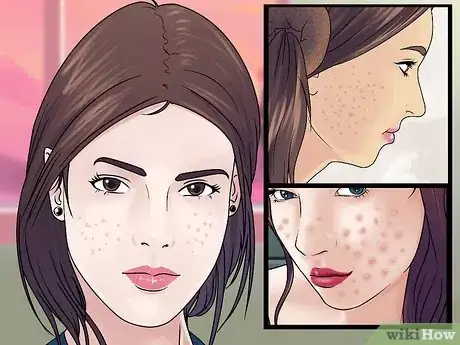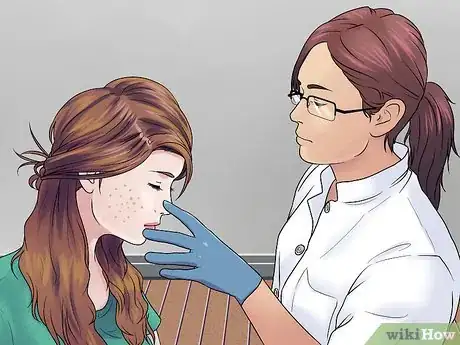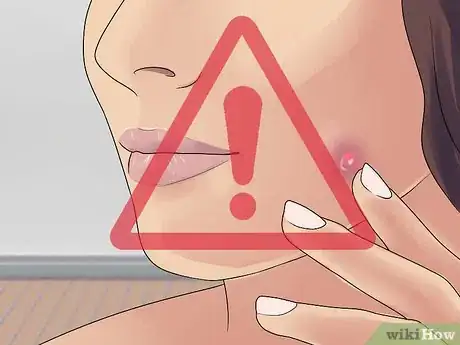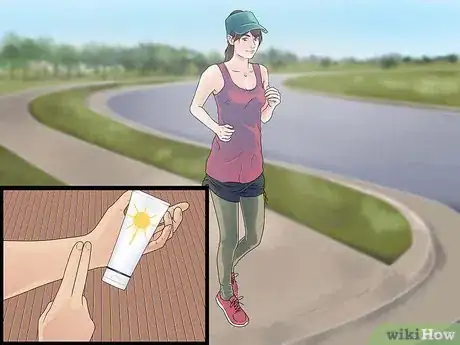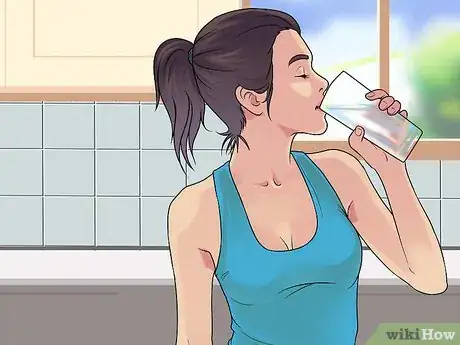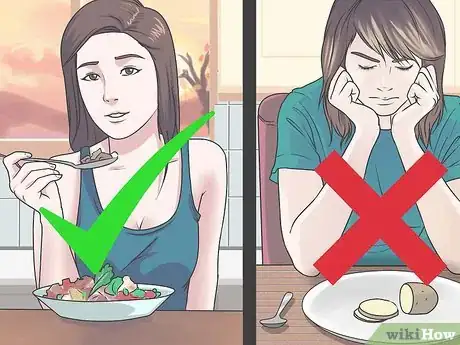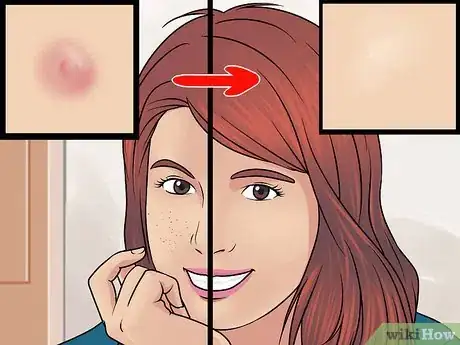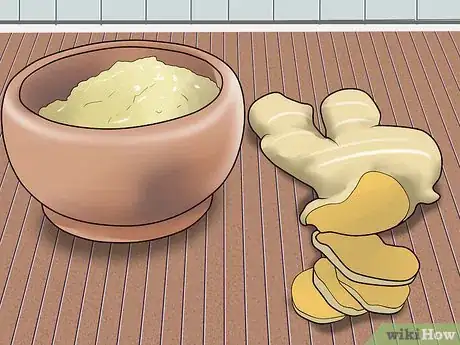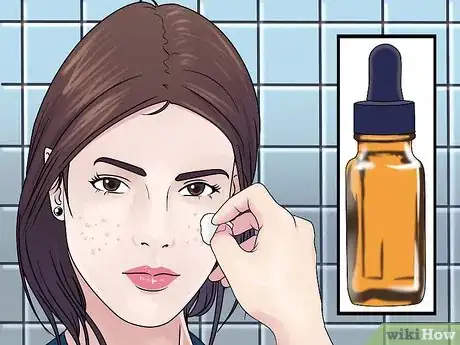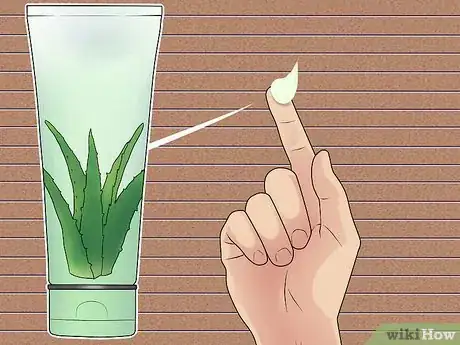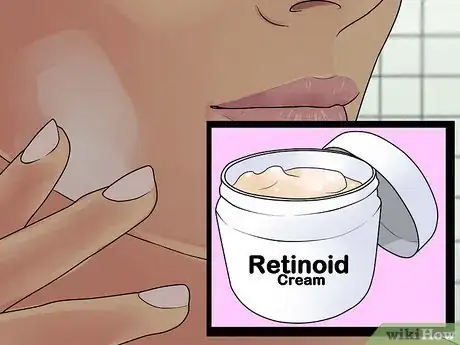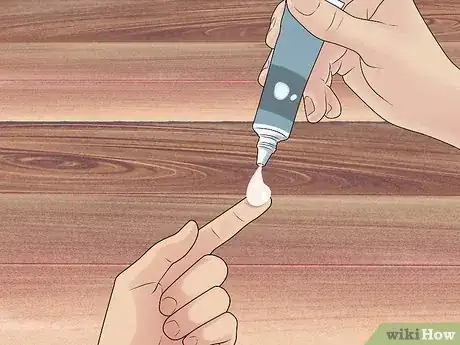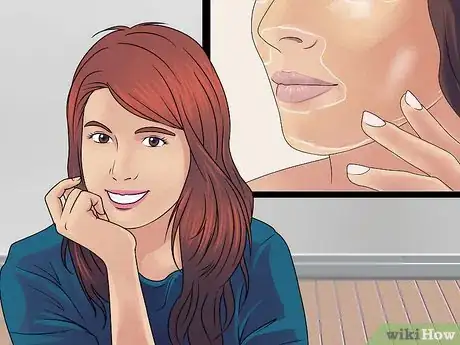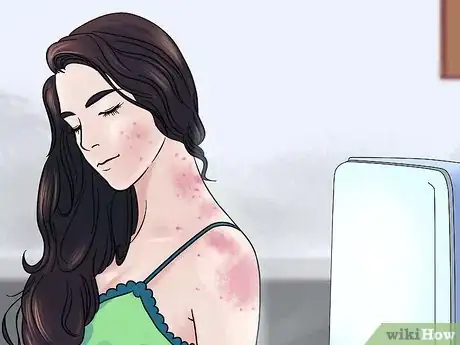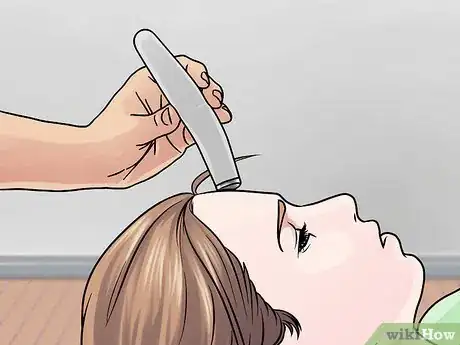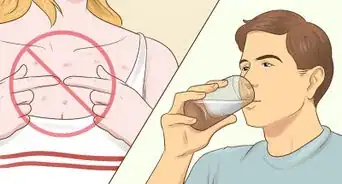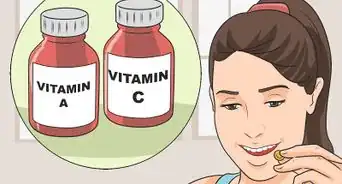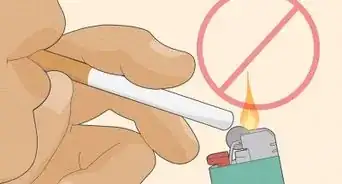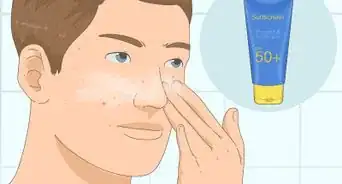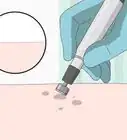This article was co-authored by Aanand Geria, MD. Dr. Aanand Geria is a board certified dermatologist, a clinical instructor at Mt. Sinai, and the owner of Geria Dermatology based in Rutherford, New Jersey. Dr. Geria's work has been featured in Allure, The Zoe Report, NewBeauty, and Fashionista, and he has peer-reviewed work for the Journal of Drugs in Dermatology, Cutis, and Seminars in Cutaneous Medicine and Surgery. He holds a BS from the Penn State University and an MD from Rutgers New Jersey Medical School. Dr. Geria then finished an internship at Lehigh Valley Health Network and a dermatology residency at the Howard University College of Medicine.
There are 27 references cited in this article, which can be found at the bottom of the page.
This article has been viewed 61,677 times.
Acne is a very common skin condition affecting many teenagers and a considerable number of adults. Nearly 85% of people experience acne at some point in their lives.[1] All types of acne can leave scars long after the initial pimples have gone. Scars detract from the smooth appearance of the skin and can make some people self-conscious and shy. However, there are steps that you can take to ensure that you keep your skin smooth and unblemished. To reduce scarring, you can use home remedies, make certain lifestyle changes, and use medications.
Steps
Treating Acne
-
1Treat acne early to avoid scarring. If you have acne, the first step to preventing scarring is to get your acne under control with the appropriate treatment. This may seem obvious, but it's true. The earlier you begin safe and effective treatment, the less chance of any skin damage or scarring. Take the time to go into your doctor or dermatologist to discuss your skin and the proper course of action.[2] There are different types of acne, including:
- Mild acne — Mild acne is characterized by the whiteheads and blackheads common to most of us.
- Moderate acne — This type is characterized by those red, angry-looking pimples called papules and those red pimples with white centers called pustules.
- Severe acne — Severe acne, also known as cystic acne, causes nodules (painful, pus-filled cysts) under the skin. This type of acne causes causes the most scarring.[3]
-
2Use an on-the-spot treatment for other pimples. As soon as you feel a pimple forming, use a spot treatment because this when such treatments are the most effective. There are different types of spot treatments, but most of them contain one of three main acne-fighting ingredients: salicylic acid, benzoyl peroxide, or sulfur.[4]
- Keep in mind that spot treatments will work on most blemishes, but won't have much effect if you're trying to treat a cystic pimple.
Advertisement -
3Visit your dermatologist when a cystic acne breakout occurs. If you have cystic pimples (pimples that stay under the skin and never develop a white head), consider getting a cortisone injection from your dermatologist. Cortisone, which is a steroid medication, will reduce inflammation drastically and will greatly reduce the chance of scarring. In addition, it will keep you from attempting to pop the pimple yourself, which increases the likelihood of scarring.[5]
- Cortisone injections work fast; they can reduce inflammation and the size of the pimple within 24–48 hours.[6]
- For an at-home treatment for a cystic pimple, you could try René Rouleau’s Anti-Cyst Treatment, which uses lactic acid and ethyl lactate to penetrate the skin and dissolve the cells clogging your pores as well as decrease bacteria and inflammation.[7] However, this may not work for many people with cysts.
-
4Refrain from picking, pricking or squeezing pimples. Primarily made out of collagen, scars are one way in which the body repairs and heals itself. Scars usually feel a bit indented on the skin due to a loss of collagen after intense inflammation. Picking or squeezing only causes more inflammation and injury to the area, in addition to pushing pus and other bacteria deeper into the skin and resulting in more collagen damage.[8]
- Don't make the mistake of thinking pimples are "ready" to be popped. Even this can cause scarring unless done by a trained dermatologist.
Changing Your Lifestyle
-
1Wash your face regularly. Keep your face clean and bacteria-free by washing it at least twice per day and after heavy sweating. Use a gentle cleanser that is ideal for your skin type (whether that be dry, oily, or combination).[9]
- Talk to your doctor about cleansers for acne-prone skin with ingredients such as benzoyl peroxide or salicylic acid.
- Wash your face from the hairline to below the jawline. Avoid harsh or abrasive scrubbing, but do be sure to really massage your facial skin with the cleaner in a circular motion. Most people don't spend enough time washing their face and leave dirt and debris behind.[10]
- Always wash your face at the end of the day to remove any makeup, sunscreen, or other remnants of the day. Use an oil-free makeup remover before washing to make sure that all makeup comes off and you're not just moving it around your face when you wash.[11]
-
2Avoid excessive exposure to sunlight. To prevent long-term skin damage, avoid staying out in the sun for too long without sunscreen. You need sunlight to synthesize Vitamin D, but too much exposure to the sun’s ultraviolet rays can damage your skin. Moreover, exposing acne spots and scars to the sun causes them to darken and derails the healing process.[12]
- Additionally, if you are using anti-acne cream therapies, like benzoyl peroxide and salicylic acid, or taking certain oral medications such as doxycycline or isotretinoin (Accutane), your skin is more vulnerable to damage caused by UV light.[13]
- Before heading outside, put on sunscreen with an SPF of 30 or higher. Note that there are a range of facial sunscreens on the market designed for acne-prone skin. Many of these are oil-free and contain salicylic acid.[14]
- Try to stay out of the sun during its peak times, between 10a.m. and 2p.m.[15]
-
3Avoid using vitamin E on scars. For a long time, it was believed that vitamin E helped scars heal faster. But recent research suggests this is not the case. In fact, applying vitamin E directly onto a scar can hinder the healing process. In one study from the University of Miami, vitamin E had either no effect or worsened the scars for 90% of patients.[16]
-
4Stop smoking. Smoking narrows blood vessels and depletes oxygen from the skin, thus slowing down the healing process. To avoid bad scarring, allow your body to heal naturally and to its fullest capability. It's important to quit smoking in order to minimize adverse interference in the healing process.
- As added incentive to quit smoking, be aware that smoking also accelerates the aging process in the skin!
-
5Keep yourself hydrated. Drink at least eight glasses of water daily. Water helps to detoxify the body and shed dead skin cells. Staying hydrated is a simple, healthy, and natural way to detox your body and may even alleviate future acne and scarring.[17] [18]
- For an added boost, add slices of lemon to your glasses of water. Rich in citric acid, lemons help to keep your body and skin healthy. The vitamin C in lemons also has antioxidants and anti-inflammatory properties and promotes the formation of collagen in the skin, and can thus help prevent acne and scarring.[19] Lemon juice is also a natural lightening agent, so may also improve the appearance of any existing scars if applied to the scars (sparingly).[20]
-
6Make dietary changes. It was long-held belief that diet had nothing to do with acne and that acne was a function of genetics, hormones, and stress. However, the American Academy of Dermatology is now taking a second look at what they had once considered a “myth": the link between acne and certain types of carbohydrates or dairy products.[21] However, the Academy is very clear to note that this link is weak at best and that there is not yet conclusive evidence of how diet may impact acne development and scarring.
- That said, however, maintaining a healthy, balanced diet full of mineral- and nutrient-rich foods is a good idea to keep your skin and body healthy. In particular, try to incorporate foods high in antioxidants (vitamins A, C, and E) because these promote healthy and fresh skin and prevent skin damage. Anti-oxidant-rich foods include carrots, butternut squash, mangoes, leafy greens, citrus fruits, nuts, seeds, etc.[22]
-
7Be patient. This is hard to do, but the biggest key to preventing and reducing acne scars is to wait. A few weeks after you have a breakout and scarring occurs, new blood vessels move into the scarred area and rejuvenate and nourish the skin. You'll know this is happening because the scar will look pink. Eventually, collagen will also start form and fill in the scarred area.[23]
- If you suffer from cystic acne, scars can take a whole year to fade. It may be difficult to wait, but try to be patient.
Using Home Remedies
-
1Make sure you are getting essential nutrients through food or supplements. Certain nutrients are absolutely essential to the health of your skin. These nutrients will allow your skin to heal effectively following an acne outbreak and will prevent the development of scars. Some of these nutrients include:
- Omega-3 fatty acids — Prevents acne by enhancing the production of prostaglandin, a hormone that helps produce healthy cells and prevents inflammation. Foods rich in Omega-3 include salmon, sardines and flax seeds.
- Zinc — There are many benefits of zinc for skin health. Zinc can reduce inflammation and scarring, as well as play a part in healing acne outbreaks. Soy, legumes, beans and high protein foods like fish, red and poultry meats are rich sources of zinc.[24]
- Vitamin A — This essential vitamin contains antioxidants, a vital component of healthy cell growth. Plant sources are the best option to get vitamin A in your diet, because they don't contain saturated fats. Vegetables and fruits like carrots, broccoli, sweet potatoes, cantaloupes, and apricots are high in vitamin A. You can also get vitamin A derivatives (known as retinoids) in the form of topical creams and lotions (see Method 4).
-
2Try lemon juice. Lemon juice is a natural bleaching agent that can reduce the appearance of scars as well as hydrate and detoxify the skin. The acid in lemon juice works to remove dead skin cells as part of skin healing and also lightens blemishes and hyperpigmentation.[25] You can use lemon juice in homemade scrubs or masks:
- Lemon Juice, Sugar, and Honey Scrub: Mix together two tablespoons of honey, one tablespoon of fresh lemon juice, one tablespoon of extra virgin olive oil, and one and 1/2 tablespoons of sugar. Then apply you to your face. Be gentle, since scrubbing could aggravate or irritate your skin. Then rinse.
- Lemon Juice, Yogurt, and Turmeric Powder Face Mask: Mix 1/4 teaspoon of turmeric powder to one tablespoon of yogurt. Add a few drops of fresh lemon juice. Stir the mixture to form a paste. Apply this paste to your face and neck. Leave on for 15–20 minutes before rinsing with a warm washcloth.[26]
-
3Use honey. Honey has antibacterial and antifungal properties that can halt bacteria and fungus from exacerbating acne scars. It also helps the pimple dry up faster and may serve as a barrier to moisture. Honey contains many beneficial nutrients and healing properties.
- Honey-Cinnamon paste: Mix three tablespoons of honey with one teaspoon of cinnamon (which has astringent and anti-viral properties). The result should be a paste that you then apply to problem areas on the skin. Leave on overnight and rinse off in the morning. Research has suggested that doing this for a period of two weeks can lead to a reduction in mild to moderate acne.[27] [28]
- Make sure you use old towels over your pillowcase, as this will likely get messy.
-
4Make a turmeric paste. Turmeric is a spice that is commonly used in Pakistani and Indian curries. Turmeric’s main known component is curcumin, a natural antiseptic and antibacterial agent. Turmeric also helps heal and rebuild damaged tissues. Try applying a topical turmeric paste:[29]
- Take one teaspoon of turmeric and make a thick paste with a few drops of water. Apply on the spots. Leave it on for as long as you can, but for at least thirty minutes. Wash off with normal water.
-
5Apply tea tree oil to the affected area. Research suggests that tea tree oil applied nightly to freshly cleansed face has similar antibacterial properties to benzoyl peroxide. Make sure to use 100% pure tea tree oil and not the products that contain tea tree oil.
- Using a cotton pad or tissue, spill a few drops of tea tree oil into it. Then apply onto the acne spots gently. Leave it for a few hours or overnight to reduce redness and swelling.
- Repeat nightly to see improvements in your skin.[30]
- Stop using tea tree oil if you experience redness, swelling, or irritation of your skin, which may occur in people with acne.
-
6Use aloe vera. This plant gel has been shown to have healing and anti-inflammatory properties. Aloe is gentle, so you won’t have to worry about it causing additional damage or irritation to your skin. In addition, aloe is a natural moisturizer and will improve the softness of skin as well.
- Aloe vera gel can be found in any drugstore or pharmacy. You should apply this gel twice daily. However, fresh aloe vera right from the plant is best. Should you choose to use fresh aloe, break off a small piece of a leaf and peel away the outer leaf to expose the gel. Then, massage the gel into your skin. Leave the gel on for at least 30 minutes so it can soak into your skin.
Using Medication
-
1Speak with a dermatologist for management and treatment. There are a number of medicated treatments and dermatological procedures available to you, but in order to know which is appropriate for you and your skin, you should consult an expert. Inappropriate use of any products or procedures could cause permanent skin damage and scarring.
- Talk to your doctor about oral medications if your acne is moderate to severe. These can include oral antibiotics, oral contraceptive pills for women, and isotretinoin (Accutane). These medications are used only under a doctor's supervision.
-
2Use a retinoid cream. Retinoid skin creams brighten and heal the skin and can be purchased both over-the-counter and with prescription.[31] Retinoids remove dead skin cells and help cells turn over more rapidly and avoid clogging in the process. They also promote collagen growth, which improves skin tone and elasticity. Results include improved smoothness of the skin and reduced discoloration and blotchiness.[32]
- Retinoid creams are also excellent in treating and preventing blackheads.
- For an over-the-counter cream, try RoC Retinol Correxion Instant Facial Smoother. Creams requiring prescription include Differin, Tazorac or Retin-A Micro.[33]
- Retinoid creams are usually applied at night after the face is washed and dried. Within a few weeks of consistent use, you should be able to see a significant reduction in acne lesions as well as an improvement in the overall health of the skin.[34]
-
3Try a cortisone cream. If your scar or acne lesions are red or swollen, cortisone creams can help calm your skin and reduce inflammation as they are absorbed by the skin cells. Cortisone is a corticosteroid hormone that reduces our body's natural defensive responses and symptoms such as swelling, itchiness, and allergic reactions. These creams can be purchased without a prescription at most drug stores and pharmacies.[35]
- You should only apply cortisone creams to your skin for a few days at a time, not long-term.
-
4Use a fade cream or skin lightener. Scars often darken the skin, so you may want to lighten these areas. Look for creams with ingredients such as Kojic acid (a natural skin lightener that comes from mushroom extract), arbutin (also known as bearberry extract), and vitamin C.[36]
-
5Try a chemical peel. In a chemical peel, a chemical solution is applied to the skin and allowed to soak in. Within one to two weeks, the skin peels off. The goal is to cause a controlled injury to the skin in order to simulate the growth of new skin, which in turn improves your skin's surface and appearance. For example, areas that were discolored or darkened by acne will likely even out and brighten.[39] [40]
- The mildest type of peel is a glycolic acid peel that works to lighten up dark spots. It can be applied to all skin types.[41] [42]
- There are many other peel options that can be tailored to your skin needs. Other common ingredients include salicylic acid, lactic acid, trichloroacetic acid (TCA), and kojic acid.
- Though you can purchase chemical peels over the counter, this is not advisable. There is too much room for error and serious injury to your skin if the procedure is not done by a professional.[43] Consult your doctor to decide whether a peel is appropriate for your skin type and condition.[44]
-
6Get laser and/or filler treatments. If your scars don't fade away on their own, you may one to consider laser or filler treatments. In one to three separate sessions, laser skin resurfacing can even out the surface of the skin and help increase the formation of new collagen, which is key to filling in acne scars. Research has suggested that laser technology can help reduce redness and the size of scars.[45] Alternatively, filler injections can help fill in acne scars. These injections generally require treatments every six to 12 months, but there are newer fillers that may even provide permanent results.
- To get these treatments, you will need to consult your dermatologist since they will need to be performed in a dermatologist's office.
-
7Try microdermabrasion. This procedure is a recent cosmetic innovation, used as an efficient alternative to invasive treatments (such as chemical peeling and laser resurfacing) to improve skin health and reduce scarring. Generally, it is a machine-assisted exfoliating treatment that utilizes tiny rough grains or crystal scrubs, such as sodium chloride and aluminum oxide, to remove the top few layers of skin and dead skin cells.[46]
- Because it produces only a superficial depth of skin removal, it is best used to treat skin with minor or superficial scars. You may need multiple or regular treatments for the best results. Results can be temporary, since your skin regenerates quickly, or they can be long lasting and cumulative.
References
- ↑ http://www.youbeauty.com/skin/how-to-get-rid-of-pimples-fast-spot-treatments/
- ↑ Aanand Geria, MD. Board Certified Dermatologist. Expert Interview. 8 July 2020.
- ↑ http://kidshealth.org/teen/your_body/skin_stuff/acne_scars.html#
- ↑ Aanand Geria, MD. Board Certified Dermatologist. Expert Interview. 8 July 2020.
- ↑ http://www.huffingtonpost.com/2013/08/09/acne-scars-prevention-treatment_n_3728437.html
- ↑ http://www.huffingtonpost.com/2013/08/09/acne-scars-prevention-treatment_n_3728437.html
- ↑ http://www.youbeauty.com/skin/how-to-get-rid-of-pimples-fast-spot-treatments/2/
- ↑ http://www.webmd.com/skin-problems-and-treatments/acne/features/acne-scars?page=2
- ↑ http://www.medicinenet.com/script/main/art.asp?articlekey=184319
- ↑ http://www.medicinenet.com/script/main/art.asp?articlekey=184319
- ↑ http://www.medicinenet.com/script/main/art.asp?articlekey=184319
- ↑ Aanand Geria, MD. Board Certified Dermatologist. Expert Interview. 8 July 2020.
- ↑ http://www.medicinenet.com/script/main/art.asp?articlekey=184319
- ↑ http://www.webmd.com/skin-problems-and-treatments/acne/features/acne-scars?page=2
- ↑ http://www.webmd.com/skin-problems-and-treatments/acne/features/acne-scars?page=2
- ↑ http://www.webmd.com/skin-problems-and-treatments/acne/features/acne-scars?page=2
- ↑ https://www.dermeffacefx7.com/info/lighten-acne-scars/
- ↑ https://www.organicfacts.net/home-remedies/home-remedies-for-acne-scars.html
- ↑ http://www.holistichealthherbalist.com/the-top-10-benefits-of-drinking-lemon-water/
- ↑ https://www.dermeffacefx7.com/info/lighten-acne-scars/
- ↑ Whitney, Bowe, MD, FAAD, Growing Evidence Suggests Possible Link Between diet and acne. American Academy of Dermatology Feb 5,2013
- ↑ http://www.webmd.com/skin-problems-and-treatments/acne/features/skin-foods?page=2
- ↑ http://www.webmd.com/skin-problems-and-treatments/acne/features/acne-scars
- ↑ http://www.mayoclinic.org/drugs-supplements/zinc-supplement-oral-route-parenteral-route/description/drg-20070269
- ↑ https://www.dermeffacefx7.com/info/lighten-acne-scars/
- ↑ https://www.dermeffacefx7.com/info/lighten-acne-scars/
- ↑ Hajheydari, Z et al. Effect of Aloe Vera topical Gel Combined with Trentoin in Treatment of Mild to Moderate Acne Vulgaris Treatment 2014 June 25 12
- ↑ Alpha HydroxyAcids.Natural Medicnes Comprehensive Databases. https//wwwnaturaldatabases.com.Accessed.com Accessed June 24 2014
- ↑ http://www.mindbodygreen.com/0-6873/25-Reasons-Why-Turmeric-Can-Heal-You.html
- ↑ http://www.earthclinic.com/cures/tea-tree-oil-treatment-for-acne.html
- ↑ http://www.huffingtonpost.com/2013/08/09/acne-scars-prevention-treatment_n_3728437.html
- ↑ Darlenski, C, Surber, J Mechanism of Action of Topical Retinoids in Cutaneous Photodamage. The British Journal of Dermatology. 2010 163 (6)1157-1165.
- ↑ http://www.huffingtonpost.com/2013/08/09/acne-scars-prevention-treatment_n_3728437.html
- ↑ Titis, Stephen, MD. Hodge, Joshua, MD, Diagnoses and Treatment of Acne. American Family Physician October, 15, 2012 86 (8) 734-740
- ↑ http://www.webmd.com/drugs/2/drug-8641/cortisone+oral/details
- ↑ http://www.webmd.com/skin-problems-and-treatments/acne/features/acne-scars
- ↑ http://www.webmd.com/skin-problems-and-treatments/acne/features/acne-scars
- ↑ http://www.huffingtonpost.com/2013/08/09/acne-scars-prevention-treatment_n_3728437.html
- ↑ http://www.medicinenet.com/chemical_peel/article.htm
- ↑ http://www.webmd.com/beauty/peels/chemical-peel
- ↑ http://www.webmd.com/beauty/peels/chemical-peel
- ↑ http://www.huffingtonpost.com/2013/08/09/acne-scars-prevention-treatment_n_3728437.html
- ↑ Rendon, M MD, Benson, D MD, Wang, B, MD, Evidence and Consideration in the Application of Chemical Peels in Skin Disorders and Aesthetic Resurfacing. Journal of Clinical and Aesthetic Dermatology 2010 July, 3 (7) 32-43
- ↑ http://www.webmd.com/beauty/peels/chemical-peel/
- ↑ Hamilton, et al, Laser and Other Light Therapies in the Treatment of Acne Vulgaris: A Systematic Review, 2009
- ↑ http://www.medicinenet.com/microdermabrasion/article.htm#what_is_microdermabrasion
About This Article
To prevent acne scarring, treat acne as soon as it arises, using a spot treatment that contains salicylic acid, benzoyl peroxide, or sulfur on any pimples that you feel forming. In addition, keep your face clean by washing it twice a day and refraining from touching it throughout the day, since the oil from your hands can irritate your skin. If you have cystic acne, which causes painful, pus-filled cysts under your skin, visit a dermatologist since it’s hard to treat this kind of acne on your own. For more tips from our Medical co-author, like how to avoid developing more acne, keep reading!
